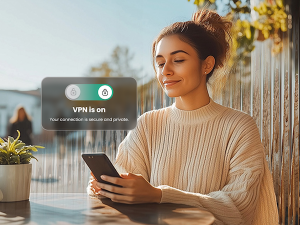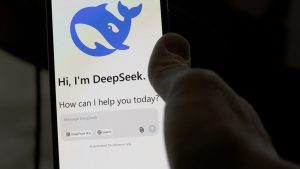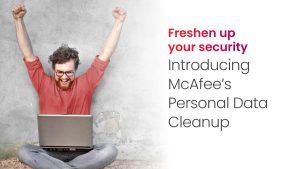Protecting your devices with antivirus is a great start, yet it’s only one part of staying safer online. With the way scammers and thieves target people today, you need to protect yourself too—specifically your identity and privacy.
Threats have evolved over the years. While hackers still wage malware attacks on computers, tablets, and smartphones, the devices aren’t the ultimate target. You are. The personal and private information created and kept on your devices have tremendous value because scammers and thieves can use it to steal your identity, open credit cards in your name, and commit all kinds of identity theft and fraud.
Yet just as using antivirus protection can keep you safer online, using privacy and identity protection will keep you far safer still. Let’s look at how all three can work in concert.
Privacy protection
Privacy protection focuses on keeping your information from getting into the hands of advertisers, cybercriminals, and data brokers who want to use it for their benefit. To boost your online privacy, consider a few thoughtful additions to your daily browsing, email, and social media routine.
First, think carefully about your social media habits. Do you post everything about your day and childhood, pin your location, and share photos of documents that include your full name, birthday, or address? You may want to consider cutting back on what you broadcast on the internet, especially if your account is public for anyone to view.
Unfortunately, while your friends and family may love your status updates, cybercriminals love them more. After only minutes of snooping, cybercriminals can glean enough personal details about you to impersonate you or target a social engineering attempt at you. To keep your private information more private, limit what you share on social media, pare down your follower and friend lists to only the closest people, and if your social media account platform supports it set your account to private.
One more way to protect your privacy is to use a virtual private network (VPN). A VPN allows you to remain far more anonymous online by shielding your location and device information, along with the data passing along your connection—which includes things like your passwords, account information, and other sensitive info.
A VPN offers further protection when you’re logged on to a public network, like those in coffee shops, libraries, and transportation hubs. Cybercriminals often lurk on non-password-protected Wi-Fi networks and eavesdrop on people paying bills or online shopping to steal their credentials.
However, criminals aren’t the only ones who intrude on your privacy. Online data brokers collect thousands of data points on millions of people, then post bits of that information for anyone to see and offer far more detailed information for a price.
Who buys this information? More legitimate purposes include people conducting background checks, journalists, law enforcement, and, largely, advertisers. With such in-depth information, advertisers can target highly specific audiences with their ads, all based on personal information that can include shopping habits from customer loyalty cards, health data from fitness apps, and information scraped from public social media posts—just to name a few of the umpteen sources they draw from.
Yet data brokers won’t discriminate. They’ll sell to scammers and thieves as well, who can then use that personal information to help them commit identity fraud and theft.
However, you can do something about this. Personal data cleanup can scan some of the riskiest data broker sites and show you which ones are selling your personal info. It can also provide guidance on how you can remove your data from those sites and can even manage the removal for you. And because data brokers continually update their data, personal data cleanup will continue to monitor those sites and help you get your information removed should it crop up again.
In all, if you feel that your privacy shouldn’t be up for grabs, a personal data cleanup service can
Identity protection
Another form of protection focuses on keeping you safer from identity theft and fraud. Here, thieves will steal personal and account information to rack up charges on existing credit and debit cards, open entirely new accounts and lines of credit, or impersonating the victim themselves for employment, health insurance coverage, or to commit other crimes in someone else’s name.
A few forms of identity crime include:
- New account theft occurs when a criminal successfully steals personal identifiable information (PII) and financial information and uses a victim’s excellent credit score to open new credit cards, utility accounts, cellphone accounts, and so forth.
- Account takeover fraud involves the use of an existing debit card, credit card, or other accounts to rack up charges—which usually happens when username and password information is stolen via a phishing attack or as the result of a data breach.
- Synthetic identity theft is a rising form of identity crime where thieves use a core piece of PII, like a Social Security Number in the U.S., to create an entirely new identity under a false name. With this “synthetic” identity, a scammer or thief can potentially open all manner of accounts, lines of credit, and even apply for benefits.
- Medical identity theft happens when thieves impersonate patients to gain access to their prescription medications or have their medical treatments paid for by the identity theft victim.
- Business identity theft can plague businesses of all sizes. Here, scammers and thieves will attempt to open new credit lines in the business’ name or send customers phony bills and collect the payments themselves.
This list provides just a few examples, yet in all its forms, identity crime can affect your finances, credit score, and ability to secure loans, a mortgage, or future credit cards.
One way to keep your identity secure is to guard your PII carefully. Never give out your Social Security Number unless it’s necessary—such for employment, opening bank and credit accounts, applying for public assistance, filing tax returns, or obtaining a driver’s license. While other businesses may ask you for your Social Security Number for identification purposes, you are not legally bound to provide it. You can ask to provide an alternate form. Also, never share it over email or text where it can be potentially intercepted.
Beyond your Social Security Number, you can take steps to protect the many other forms of personal information you have. An identity monitoring service can keep tabs on everything from email addresses to IDs and phone numbers for signs of breaches so you can take action to secure your accounts before they’re used for identity theft. Likewise, credit monitoring can watch for unusual credit activity that could be an indicator of identity theft as well.
Should the unfortunate occur, identity theft & recovery coverage like ours can help you get back on track in several ways. First, it provides $1 million in identity theft coverage that covers travel expenses, legal fees, and stolen funds reimbursement. Additionally, it provides the assistance of a licensed identity theft recovery pro who can help you repair your identity and credit.
Device security
The third form of protection involves our devices, like computers, tablets, and phones—protecting them from both physical and digital threats.
The first step you can take is to use a password, PIN, facial recognition, or other form of lock to keep your devices safer in the event of loss or theft. With this protection, your device is effectively an open book, providing a thief with access to all manner of personal information, accounts, and apps.
Taking this protection a step further is learning to remotely locate your devices and then lock or wipe them. Many laptops and mobile devices offer location tracking services to help find a lost device—and yet others allow the owner to remotely lock or even wipe the contents of that device if they fear it’s lost for good or fallen into the wrong hands.
It’s all rather straightforward, and device manufacturers have put up helpful web pages that can walk you through the process:
- Apple provides iOS users with a step-by-step guide for remotely wiping devices
- Google offers up a guide for Android users as well
- For laptops, Microsoft and Apple users can take the following steps:
- Windows: Enable in Settings > Update & Security > Find my device
- macOS: Enable via Settings > Your Name > iCloud > Find My Mac
Another good step you can take is to back up your files, whether with an online cloud service, a physical external drive, or both. By storing your files in the cloud, you can recover them quickly if your device is stolen and you have to remotely wipe its contents. Storing them on an external drive also lets you recover your files if your device is stolen, however, you’ll want to keep it in a secure location so that it can’t be stolen as well. Options include a fireproof safe where you keep other valuables or even a safe deposit box. The drawback is that you will have to back up files manually and regularly whereas cloud backup is practically automatic when you’re connected to the internet.
Another component of device security is defending against malicious software. Viruses and malware can make their way onto your devices through several avenues, including sketchy websites, dishonest downloads, phishing schemes, and clicking on ads. The challenge is that several of these avenues can look rather legitimate at first glance. Sophisticated hackers, scammers, and thieves have learned how to make their bogus websites and search results look like the real thing. One way you can prevent making a bad click or downloading an attachment loaded with malware is to use web advisor software that can protect you while you browse.
And finally, yes, antivirus is a must now just as it’s ever been. When kept up to date with the latest updates, it can prevent malware from getting onto your devices—plus scan, detect, and delete viruses and malware from your devices should they make their way onto them.
Protecting your privacy, identity, and devices—today calls for all three
The threats out there are many, and they go beyond threats to your devices. Hackers, scammers, and thieves are quite interested in you. Your accounts, your personal information, and anything they can grab to commit theft or fraud. Protecting yourself today calls for not only protecting your devices but your privacy and identity too.
Comprehensive online protection software like ours covers all three—privacy, identity, and devices. It includes the protections mentioned above, plus dozens of features more such as ransomware coverage, credit freezes, security locks, and an online protection score that shows you just how safe you are, along with suggestions that can make you safer still.
In all, it gives you far more control over your privacy and personal information, control that should rest in your hands, and not in the hands of data brokers, hackers, scammers, and thieves.












